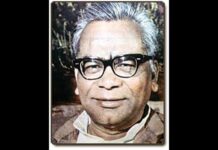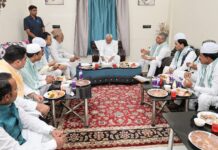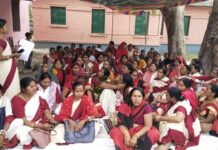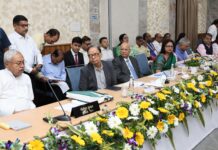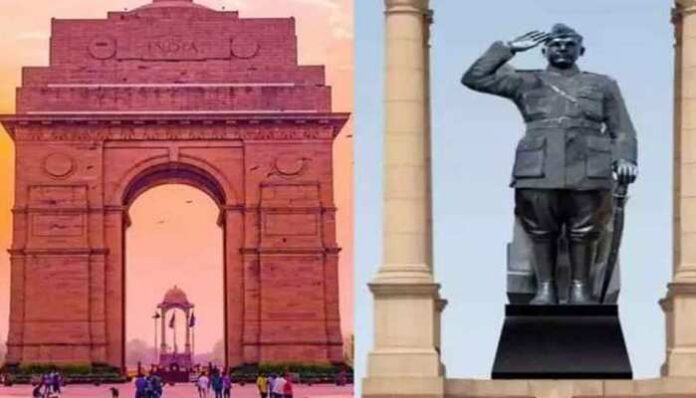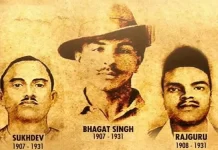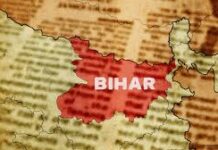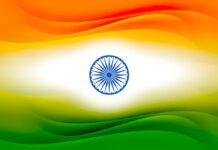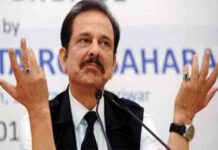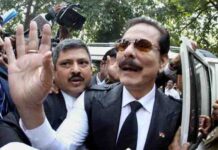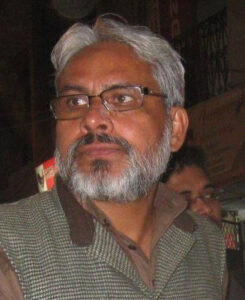
Prem Singh
In a TV channel debate, BJP spokesperson and anchor shared and served a lie that Netaji Subhas Chandra Bose’s daughter in her letter to the Prime Minister has alleged that the Congress kept devaluing Netaji to further Gandhi’s non-violence; because Netaji had taken the path of liberating the country through violence mode by forming the Azad Hind Fauj (INA). They also praised the Bombay Royal Naval Mutiny of 1946 to confirm that the country got its independence through a violent route. I stated that I have read the letter of Netaji’s daughter, and there is no such allegation in it. But a lie told in the intoxication of power bound to be blatant.
Netaji’s daughter Anita Bose Pfaff, even in the past, has already requested some earlier prime ministers of the country to bring back the mortal remains of her father from Japan to India. In none of the letters she has spoken about devaluation of her father’s role in the freedom movement on the basis of Gandhi’s non-violent mode of action. In all her statements, she has been considering the independence of India as the result of the efforts of all the institutions and leaders, including the Azad Hind Fauj formed by Netaji. She has also believed, which seems true, that Gandhiji, at times, could not handle the versatile personality of her father. She has been a professor of economics. Her statements reveal that she has a settled and subtle intellectual and political personality. Pfaff, also a leader of the Social Democratic Party of Germany, may also had been influenced by her father’s socialist ideas. However, in India these days there is no dearth of journalists reporting her statements in an erratic and childish manner.
In her communications she has always urged the leaders of India and Japan to bring the remains of her father back to India from the Renkoji Temple in Tokyo. In the letter to the prime minister Narendra Modi too, she has expressed her gratitude to him for the installation of Netaji’s statue at the historic India Gate of the country’s capital, and reiterated her everlasting demand to bring the remains of Netaji to India. In this letter, she has not made any allegation against anyone. Rather, as before, in the letter to the present prime minister, she has appealed to the opposition leaders and citizens to co-operate in bringing Netaji’s remains to India. She has also offered to conduct a DNA test of the preserved ashes, to put an end to the speculations about Netaji’s death. However, she does not see the need for a DNA test in view of the clear evidences of Netaji’s death on 18 August 1945 in the plane crash. Netaji and her Austrian wife Emilie Schenkel’s daughter, born in Vienna, has turned 80. She was three years old at the time of her father’s death. Her fondness for his father’s remains is natural.
Netaji’s formation of the Azad Hind Fauj and armed military struggle with the British government is a very small part of his activism in the freedom movement. Netaji had a great personality. But the RSS/BJP want to construct the image of Netaji that of a Hindu-militarist by emphasizing his role associated only with the Azad Hind Fauj. That is, the RSS/BJP needs a violence-loving ‘Hindu’ Netaji. (Whereas, VD Savarkar himself had said that “Bose did not differ very much from Mahatma Gandhi, except that he went further to woo the Muslims.”) Here the question is, does his efforts for the independence of the country through the Azad Hind Fauj come in the category of plain violence? And was that violence answer to the non-violence of Gandhi? Did Netaji make any such claim during or after the formation of the Azad Hind Fauj? Was Netaji’s army a Hindu army? There is no such thing in the light of facts. In fact, the RSS/BJP are no longer satisfied with merely putting up a portrait of Savarkar in the Central Hall of Parliament. They want to establish the superiority of Savarkar’s violence over Gandhi’s non-violence. This mind-set sees patriotism in Savarkar’s apologies, valour in inciting the youth to kill enemies and a vision in recruiting Indians into the British Army to militarize the country. Therefore, it would be appropriate to give some thought to the violence of Savarkar and the intention of the RSS/BJP to set it up.
The question of violence-non-violence had arisen in the Indian freedom struggle since 1857. India’s budding middle-class did not support the soldiers who rebelled against colonialism and the peasant-artisans and certain princely states who supported them in the rebellion. The horror of the horrific violence that took place during and after the repression of 1857 kept dominating the Indian society for the next four decades. The silence of this horror was broken by the eldest of the Chapekar brothers, Damodar Hari Chaphekar, on 22 June 1897 by shooting and killing the District Magistrate of Pune Walter Charles Rand and his assistant Oyster. With this incident the armed revolutionary movement got a start in the Indian freedom struggle.
As the revolutionary movement progressed, the violence-non-violence debate took a new turn. Gandhi gave a new dimension to this debate by proposing the philosophy of non-violence. Against Gandhi’s philosophy of non-violence, the revolutionaries put forward their ‘philosophy of the bomb’. The revolutionaries made it clear in their philosophy that the violence of the revolutionary movement is not related to the violence based on the ‘philosophy’ of lies, deceit and conspiracy. Gandhi praised the bravery of the revolutionaries, and advised them to follow the right path of non-violence. He also said that non-violence cannot be the weapon of cowards. Gandhi also tried to convince Savarkar that the great goals of human life cannot be achieved through lies, deceit and conspiracy. When Gandhi met Savarkar and some of the youths influenced by him at India House in London, he had some realization that India had to achieve a greater goal for humanity along with its freedom. After that meeting and discussion, Gandhi composed ‘Hind Swaraj’ in the ship while returning from London.
When Savarkar came out of jail in 1924, the revolutionary movement had entered a new ideological phase. The Hindustan Socialist Republican Association (HSRA) had been founded by Bhagat Singh and his comrades in 1924 and the Bharat Naujawan Sabha in 1926. Netaji presided over the Lahore session of the Bharat Naujawan Sabha in 1929. Savarkar’s violence could not find any track with the violence of the revolutionaries. Opposition to the independence movement and support for colonial power was the natural culmination of his path. And the same thing happened. He remained loyal to the British till the end. Even after independence, his ‘fame’ is associated with the case of Gandhi’s assassination. He had refused to even recognize Nathuram Godse in the court as per his familiar tactic. But it is believed that the last statement of Godse given in the court was penned by Savarkar, a prolific writer. He had also done this job for the revolutionary martyr Madanlal Dhingra 40 years ago. However, the London court did not allow Dhingra to read the statement.
Savarkar lived till 1966, but no remarkable positive work in the service of the country and society is recorded in his account. Those who believe that patriotism was hidden behind Savarkar’s apologies, it can be said that they neither know about the revolutionary movement nor about the open movement of the people of India. Those who see the ‘vision’ of India’s militarization in the venture of Savarkar to recruit Indians in the army to fight in the Second World War, may not know that the Indians were not recruited as officers in the British Army, but were recruited as soldiers to become cannon fodder on the war fronts while fighting in India and abroad.
There is a need to understand the implications of RSS/BJP’s exercise of dragging Netaji into the fringes of violence. Netaji is a big name in the history of freedom movement. He has a deep reputation among the public. In the eyes of some, he is the most popular figure in India after Gandhi. The RSS/BJP feel it would be easy to drag Bhagat Singh and other ‘Hindu’ revolutionaries into the court of Savarkaraite violence under Netaji’s headship. But the matter does not end here. The RSS/BJP, ultimately, want to get rid of Gandhi and his philosophy of non-violence ‘responsible for making the country a coward’ by selective appropriation of Netaji and revolutionaries. Savarkar, in his book ‘The Indian War of Independence 1857’ has described the sepoy-rebellion, which was termed as Ghadar (mutiny) by the British, as India’s first war of freedom struggle. In his book he has also celebrated the violence a lot. But the RSS/BJP do not invoke 1857 against Gandhi’s non-violence. Because the Hindu-Muslim unity of that first major war of independence from colonialism comes in the way of their communal politics based on majoritarianism.
Many Indians with slave and coward mentality did not take part in perhaps the most spectacular freedom struggle in the world. The leaders of the Muslim League, Hindu Mahasabha, RSS, including princes, big and small government officials, dhannaseth, and various type of internationalists were among those Indians. In spite of this fact, the Prime Minister, and then the RSS/BJP ideologues are constantly repeating that by installing the statue of Netaji, they have liberated the country from colonial mind-set. They perhaps are not ready to accept that the delusions spread with the help of political power would be cleared one day or the other.
Anyway, what will be the outcome of all this exercise of the RSS/BJP, only the future will tell? But at present it is clear that by doing all this the RSS/BJP are distorting the true spirit of the freedom movement, devaluing the national leaders by dragging them into petty politics, and also insulting the Indian people who participated in the freedom movement sacrificing even their lives. While doing all this, when the RSS/BJP refer to sometimes Krishna, sometimes Arjuna, sometimes Chanakya etc., then these mythological-historical figures are also insulted. It would be better for the RSS/BJP and their supporters to try to change the mind-set of slavery and cowardice rather than hiding it with various tricks.
Post-script: On the appropriation of Netaji by the RSS/BJP, the progressive secular camp, while citing his socialist and secular views, has reiterated its old argument that the RSS/BJP cannot digest Netaji. The same argument was also propagated at the time of appropriation of thinkers/leaders such as Vivekananda, Bhagat Singh, and BR Ambedkar etc. Even after three decades of neo-colonial assault, the intellectuals of India are not ready to accept that in the era of corporate politics, national leaders/thinkers are appropriated not for their ideas/actions, but for their colorful use in favor of neo-liberalism; icons who fought against colonial domination are dragged into the hammam of neo-colonial slavery. North-South-East-West – political parties operating in all parts of India are doing more or less the same. An example should suffice in this context. Those loving children of Ford Foundation like Arvind Kejriwal who campaign against reservation under the aegis of Youth for Equality, make the corporate-communal nexus acceptable to the progressive secular camp have Bhagat Singh and Ambedkar as their ‘ideal’! In this game of corporate politics, Gandhi’s position has been made that of a Panchayati child. When parties/leaders need him they fondle him, otherwise he would be scold.
(The writer associated with the socialist movement is a former teacher of Delhi University and a fellow of Indian Institute of Advanced Study, Shimla)






